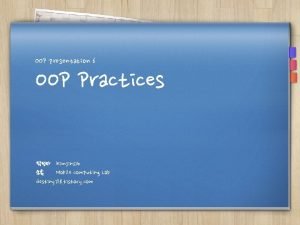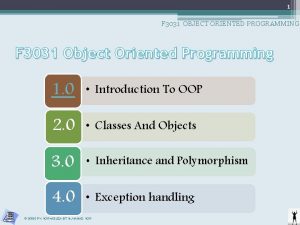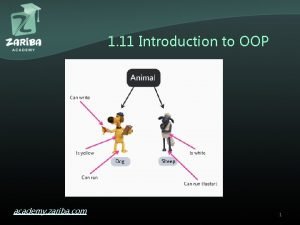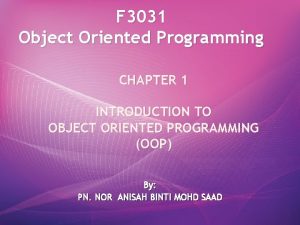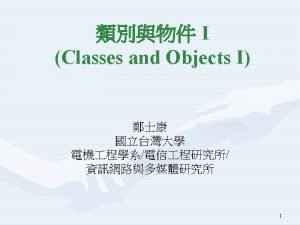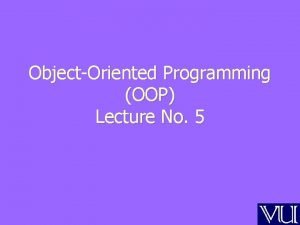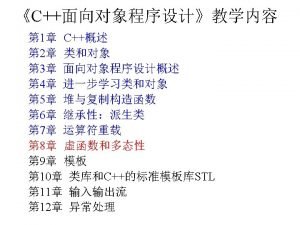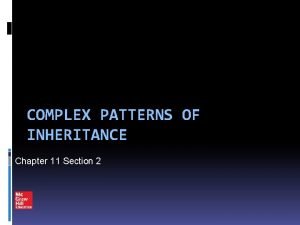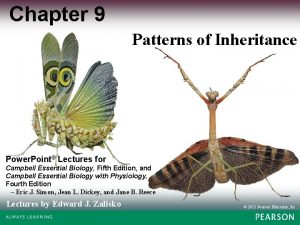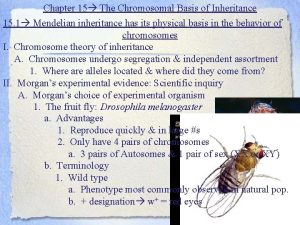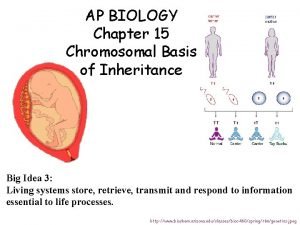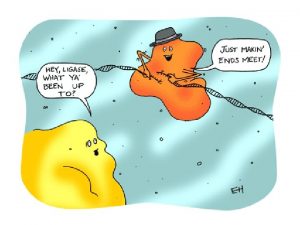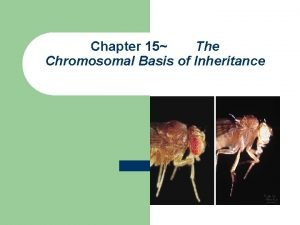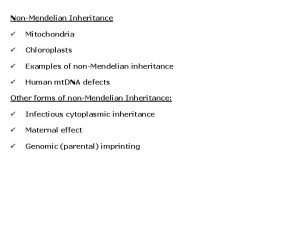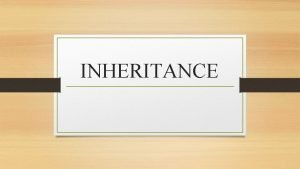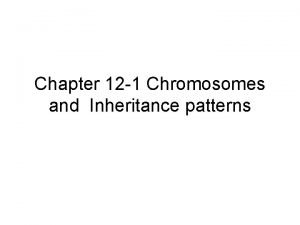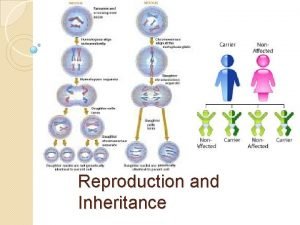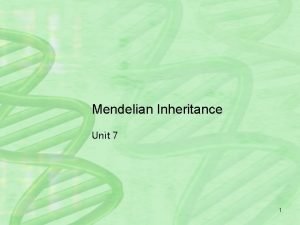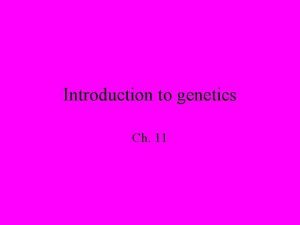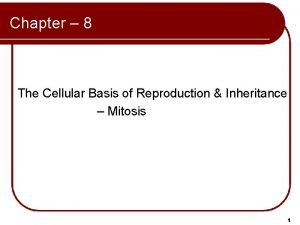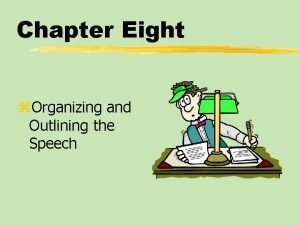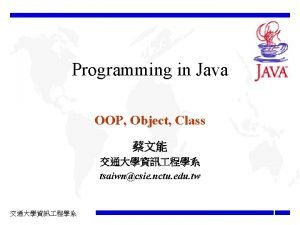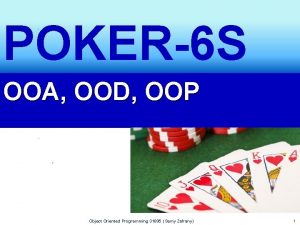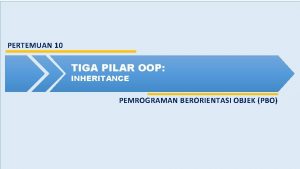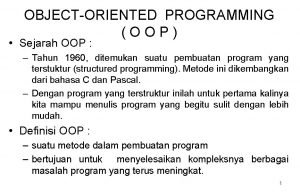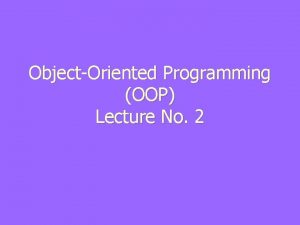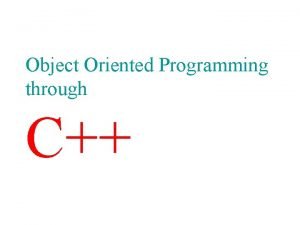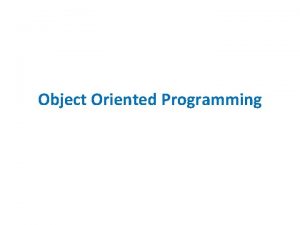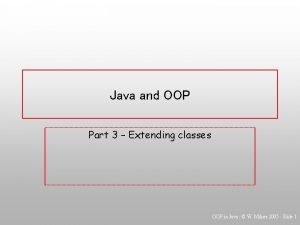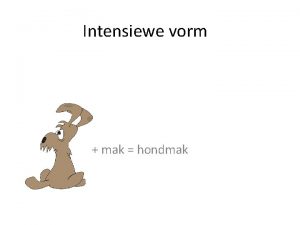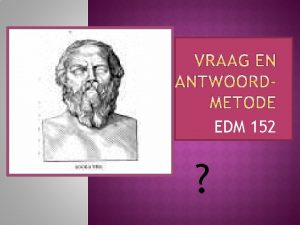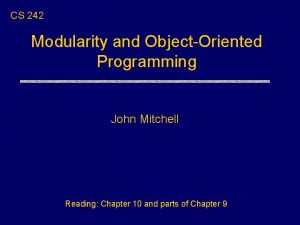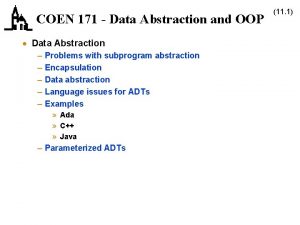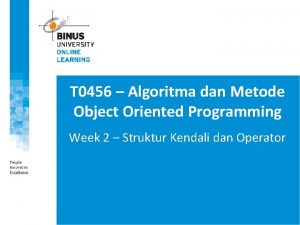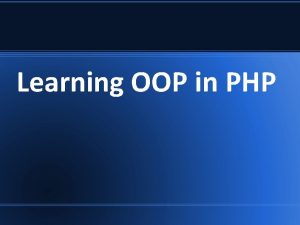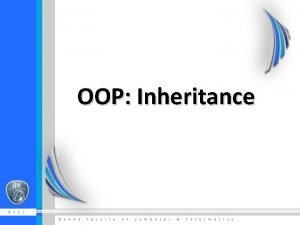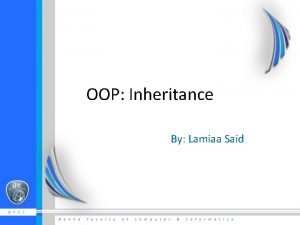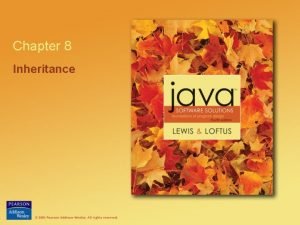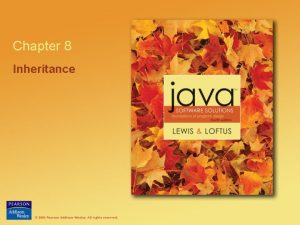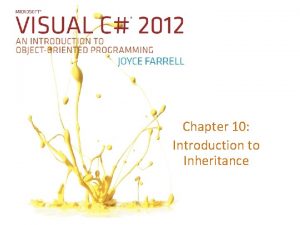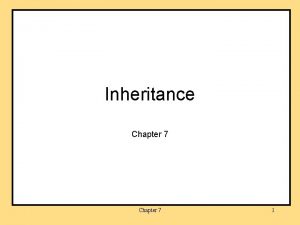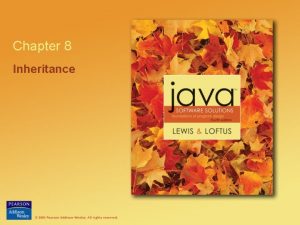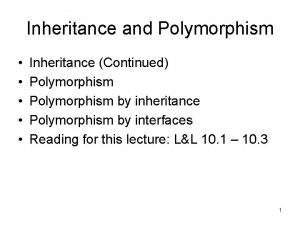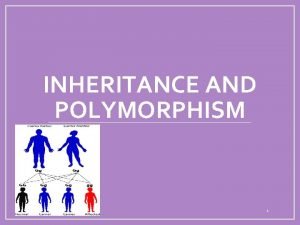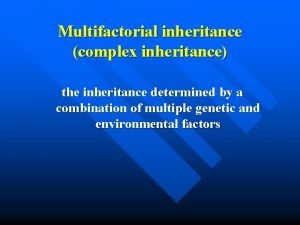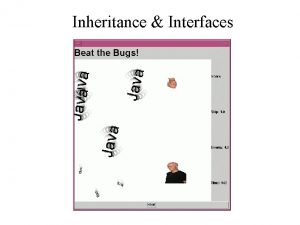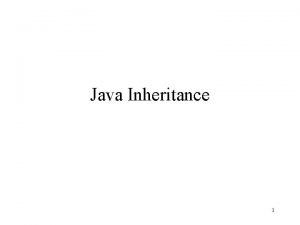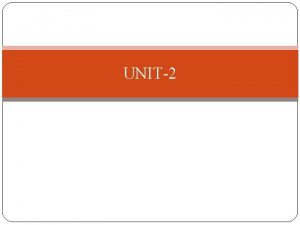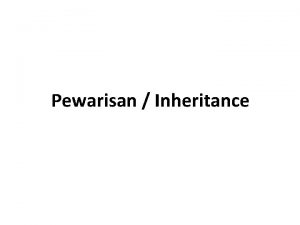Inheritance and OOP Chapter 11 Chapter Contents Chapter




































![Objects Object Kind Name program Type Payroll. Generator Employee seq Employee[ ] varying employee Objects Object Kind Name program Type Payroll. Generator Employee seq Employee[ ] varying employee](https://slidetodoc.com/presentation_image_h/767648686a12aab195afac5f56e39275/image-37.jpg)













- Slides: 50

Inheritance and OOP Chapter 11

Chapter Contents Chapter Objectives 11. 1 Introductory Example: A Trip to the Aviary 11. 2 Inheritance and Polymorphism 11. 3 Example: Geological Classification 11. 4 Example: An O-O Payroll Program 11. 5 Graphical/Internet Java: A Function Plotter

Chapter Objectives n n Learn how classes are designed and built Learn about inheritance and polymorphism Illustrate the power of inheritance and polymorphism with case studies Use OOD to develop a function-plotting GUI application

Objects n Organized into groups with similar characteristics n n they are said to be related by a common characteristic Object-Oriented programming seeks to provide mechanisms for modeling these relationships n this is where the Java word extends is used

11. 1 Intro Example: A Trip to the Aviary n Consider a collection of birds which have different properties n n name color (some of the same name are of different colors) We seek a program to simulate this they eat different things collection they make different noises some make multiple kinds of sounds

Design Sketch n Key is to design a Bird class hierarchy. n Strategy n n n design classes for objects identify characteristics classes have in common design superclasses to store common characteristics

Hierarchy Bird Walking. Bird call: ? color: ? food: ? movement: walked call: ? color: ? food: ? movement: ? Goose Ostrich call: honk color: gray food: bugs call: neek-neek color: brown food: grass Flying. Bird call: ? color: ? food: ? movement: flew Parrot Owl call: Squawk color: ? food: fruit call: ? color: ? food: mice Talking. Parrot. . .

Coding n Note Bird class, Figure 11. 1 n Attributes common to all birds n n n color food movement

Features of Bird Class n Note attribute missing but get. Call() method present n n n my. Call varies in random fashion for different kinds of birds get. Call() is an abstract method –no definition in the Bird class for the method Note to. String() method invokes get. Call() even though not defined n classes which extend Bird will so provide

Subclasses // Flying. Bird provides subclass of Bird abstract class Flying. Bird extends Bird { public Flying. Bird (String color, String food) { super (color, food, "flying"); } } Values passed to Bird class constructor where used to initialize attribute variables defined in class Bird

Subclasses // Parrot provides subclass of Flying. Bird class Parrot extends Flying. Bird { public Parrot(String color) Note "is a" relationship: a { super(color, "fruit"); parrot } is a flying bird. public String get. Call() Similarly, a Parrot is a Bird { return "Squawk!"; } } Movement attribute not an argument for constructor, a parrot is already specified as a flying bird

Aviary Class n n Note source code, Figure 11. 1 n Array of Bird objects n Initialized as individual subclass objects Ostrich, Goose, Parrot, etc. Random element of array chosen n n assigned to Bird handle, a. Bird when a. Bird printed, to. String method prints specifics unique to the subclass type of bird chosen

11. 2 Inheritance and Polymorphism Superclass n Declaring subclasses class B extends A {. . . } n means class B is a specialization of class A n n the "is a" relationship exists a B object is an A object A increasingly general "is a" B Subclass increasingly specialized

Inheritance n Other names: n n superclass also called "parent class" subclass also called "child class" These names help understand concept of inheritance Child class inherits characteristics of parent class n n attributes methods

Inheritance n When we say … class Talking. Parrot extends Parrot { … } n n n then a Talking. Parrot object inherits all Parrot attributes (which, in turn, inherits both Flying. Bird and Bird attributes) In general, descendant classes inherit the attributes of ancestor classes

Results of Inheritance n n Used to eliminate redundant coding When we send to. String() message to a Goose or Parrot or Talking. Parrot object n none of these classes implement the to. String() method n but … they inherit it from Bird n to. String() need not be redefined in the subclasses

Handles and extends n is unidirectional. A extends B does NOT imply that B extends A Consider the declaration: Bird abird = new Goose(); n n n extends this is legal a Goose object "is a" Bird object Contrast Goose a. Goose = new Bird("gray", "walking", "bugs"); n n this is NOT legal A Bird object is not necessarily a Goose object

Polymorphism n Consider Bird bird 1 = new Parrot("green"), bird 2 = new Talking. Parrot("red", phrases); n n A call to. get. Food() uses the method from class Bird Contrast invocation of. get. Call() n n uses methods specific to the classes Parrot and Talking. Parrot When a method is called n n system looks for local method of that name otherwise it looks for an inherited method

Polymorphism Principles: n n A method defined in a class is inherited by all descendants of that class When a message is sent to an object to use method m(), any messages that m() sends will also be sent to the same object If the object receiving a message does not have a definition of the method requested, an inherited definition is invoked If the object receiving a message has a definition of the requested method, that definition is invoked

Java Hierarchy n n The classes we have been using throughout the whole text are organized into a hierarchy Object is the common ancestor n n n every class inherits characteristics of this class for example: clone(), equals(), get. Class() and to. String() Every class must fit within the Java class hierarchy

Object-Orient Design (OOD) n Identify the problem's objects n n n Identify the operations If an operation cannot be performed with an existing operator or method n n n if an object cannot be represented by an existing type, design a class to do so if two or more classes share common attributes, design a hierarchy define a method to do so store the method within a class hierarchy to enable inheritance Organize the objects and operations into an algorithm

O-O Design Issues Using the extends relationship: A class B should extend another class A if and only if n B "is a" specialized version of A and … n All messages that can be sent to A can be appropriately sent to B A B

Abstract Methods and Classes Suppose we need to be able to send a message to a class but there is no clear way to define the corresponding method in that class. Solutions: 1. Define a "generic method" within the class to provide a default behavior • subclasses override it as necessary 2. Declare the method within the class as abstract • leave it up to the subclasses

Attribute Variables vs. Methods Should we represent a class attribute using an attribute variable and accessor method or only a method? Principle: n n If an attribute value can be stored in a variable and retrieved in a method … Do so in such a way as to exploit inheritance and avoid redundant coding.

Initializing Inherited Attributes How can a child class constructor initialize the attribute variables it inherits from its parent class … it is not permitted to access directly the private attribute variables ? ? ? Rules for invoking a constructor in a parent class: 1. The super() method can only be invoked by another constructor method 2. It must be the first statement in that method n inherited attribute variables must be initialized before any non inherited attribute variables

Accessing Private Information from an Ancestor Class n When the ancestor class declares an attribute as private n n both users and descendents of the class are prevented from accessing the attribute Java provides the protected modifier n n users of the class are prevented descendents of the class are allowed to access the attribute

Invoking an Inherited Method of the Same Name n We know that an inherited method can be overridden by another method of the same n n n most local (overriding) method takes precedence Occasionally we wish to call the inherited method If B extends A and both have a method m() n n The m() method for A can be called from inside B Use the syntax super. m()

11. 3 Example: Geological Classification n Problem: rocks classified according to nature of origin n n Sedimentary Igneous Metamorphic We seek a program that given the name of a rock, displays a simple geological classification

Objects Object Type Kind Name A rock Rock varying a. Rock chalk Chalk constant shale Shale constant . . . description String varying We need classes for each kind of rock a. Rock. get. Description()

Strategy n n Create a class for each kind of rock Note that classification is a characteristic of rocks n n n represent classification with a String attribute supply a get. Classification() method Summarize relationships with class hierarchy diagram

Rock Class Hierarchy

Operations At the very least, each class should have: n A constructor n Accessor methods for class attributes n A to. String() method to facilitate output Also: n get. Description() method in each class n Attribute variable and accessor for which of the three categories

Coding n n Class declarations, Figures 11. 12 through 11. 16 Algorithm 1. Prompt user for name of rock 2. Read name into rock. String 3. Build instance of class whose name is stored in rock. String 4. Display result of sending that object the get. Description() message

Coding n. Main n n program, Figure 11. 1 Note the program did not use if-else-if to beto cast intobased our determine which must class use on input handle's type, Rock Instead it used Class class aclass = (Rock) Class. for. Name(rock. String). new. Instance(); returnsan a actual Class instance object of this creates the class object sent to representing thatrock. String class new. Instance() class and reference to it passed to method for. Name() method

Constructing an Object from a String Form: class. for. Name(String. Variable). new. Instance() Where: String. Variable refers to a String containing the name of a class Purpose: n n Returns instance of class whose name stored in String. Variable Created using default constructor of that class new. Instance returns that instance as an Object It must be cast into appropriate type (usually nearest ancestor)

11. 4 Example: An O-O Payroll Program n n Consider a program to generate monthly paychecks for employees. Includes different kinds of workers, paid different ways n n n managers & programmers, salary secretaries & consultants, hourly Program should read sequence of employees from file, compute pay, print paycheck
![Objects Object Kind Name program Type Payroll Generator Employee seq Employee varying employee Objects Object Kind Name program Type Payroll. Generator Employee seq Employee[ ] varying employee](https://slidetodoc.com/presentation_image_h/767648686a12aab195afac5f56e39275/image-37.jpg)
Objects Object Kind Name program Type Payroll. Generator Employee seq Employee[ ] varying employee Input file Buffered. Reader( File. Reader( file. Name)) varying emp. File name String varying args[0] Employee varying employee[i] Managers Manager varying . . Pay . . . double varying employee[i]. pay() Paycheck varying paycheck Emp. name String varying employee[i]. name()

Analysis n Common attributes n n salary for managers, programmers hours and hourly wage for secretaries and consultants name, id, pay, etc. for all employees Suggests superclass of Employee, subclasses of: n. Salaried employee n. Hourly employee nmanager n. Consultant nprogrammer nsecretary

Hierarchy

Operations Operation Responsibility of: 1. Read sequence of employees from file (open file, read, close) Payroll. Generator, Employee subclasses 2. Compute an employee's pay Employee 3. Construct paycheck Paycheck 4. Access employee name Employee 5. Access ID number Employee 6. Access employee pay Employee subclasses

File Format n n First line contains number of employees to be read from file Subsequent lines contain info in employee records n note that different kinds of records contain different kinds of attributes salaried employee records have salary n hourly employee records have both hours and wages n

Algorithm 1. Read the sequence of employee records from input file into employee array 2. For each index i of employee a) build a paycheck for employee[i] b) output that paycheck n Note class declarations, Figures 11. 18 through 11. 23, Payroll. Generator program, Figure 11. 23

Program Expansion n n If company hires an employee of a new type (say janitor) n build a Janitor class that extends Salaried. Employee or Hourly. Employee n Add the janitor data to the file Note the simplicity of the expansion n no other modifications necessary to the program

11. 5 Graphical/Internet Java: A Function Plotter n We seek a program for use in a mathematics class n n n Program allows user to: n n n plots the graph of a function helps visualize function behavior choose a function to be plotted specify range of values Program should be easily expandable for including new functions

Behavior Function Plotter Function (Clear) Sine X max 4. 0 Y max 4. 0 Cosine Log 10 Power X min 4. 0 Y min Function chosen will be graphed on the axes 4. 0 Colors

Hierarchies n n n Function. Panel will extend Cartesian. Panel already extends JPanel Make the functions we will graph to be objects n n n build a class to represent each this makes future expansion easily done take advantage of polymorphism

Polymorphism n Each function class has a polymorphic value. At() method given an x-value, returns corresponding yvalue for that function Function my. Function = (Function)Class. for. Name (function. Name). new. Instance(); . . . y = my. Function. value. At(x); n

Coding n n n Parent class Function, source code Figure 11. 25 Subclasses for different functions, source code Figures 11. 26 through 11. 29 Class Colored. Function, source code Figure 11. 30 n uses a wrapper class that encapsulates Function and Color into a single class

Function. Panel Class n n Its only attribute variable is the Function it draws (see Figure 11. 31) Methods n n n constructor accessor mutator clear() to erase function the paint. Component() to draw the function

The action. Performed() Method n JButton, JCombo. Box, etc are components that fire Action. Events n n n Use instanceof operator n n must implement Action. Listener interface also define action. Performed() method determines which action user performed Figure 11. 33 shows coding
 Oop.oop~f
Oop.oop~f Oop.oop~f
Oop.oop~f Oop slides
Oop slides Oop
Oop Encapsulation inheritance and polymorphism
Encapsulation inheritance and polymorphism Diamond problem oop
Diamond problem oop Oop inheritance polymorphism encapsulation abstraction
Oop inheritance polymorphism encapsulation abstraction Chapter 11 complex inheritance and human heredity test
Chapter 11 complex inheritance and human heredity test Chapter 11 section 2 complex patterns of inheritance
Chapter 11 section 2 complex patterns of inheritance Chapter 16 the molecular basis of inheritance
Chapter 16 the molecular basis of inheritance Chapter 15 the chromosomal basis of inheritance
Chapter 15 the chromosomal basis of inheritance Chapter 9 patterns of inheritance
Chapter 9 patterns of inheritance Chapter 16 the molecular basis of inheritance
Chapter 16 the molecular basis of inheritance Chapter 15: the chromosomal basis of inheritance
Chapter 15: the chromosomal basis of inheritance The chromosomal basis of inheritance chapter 15
The chromosomal basis of inheritance chapter 15 Chapter 15 the chromosomal basis of inheritance
Chapter 15 the chromosomal basis of inheritance Chapter 11 section 1 basic patterns of human inheritance
Chapter 11 section 1 basic patterns of human inheritance Chapter 11 section 1 basic patterns of human inheritance
Chapter 11 section 1 basic patterns of human inheritance Primase
Primase Chapter 9 patterns of inheritance
Chapter 9 patterns of inheritance Chapter 15 the chromosomal basis of inheritance
Chapter 15 the chromosomal basis of inheritance Maternal effect and maternal inheritance
Maternal effect and maternal inheritance Advantages and disadvantages of inheritance in java
Advantages and disadvantages of inheritance in java Maternal effect and maternal inheritance
Maternal effect and maternal inheritance Section 12-1 chromosomes and inheritance
Section 12-1 chromosomes and inheritance Reproduction and inheritance
Reproduction and inheritance Difference between mendelian and non mendelian inheritance
Difference between mendelian and non mendelian inheritance Mendel's first and second law of inheritance
Mendel's first and second law of inheritance Sex cat
Sex cat The cellular basis of reproduction and inheritance
The cellular basis of reproduction and inheritance Cause and effect contents of the dead man's pocket
Cause and effect contents of the dead man's pocket Oblique sinus
Oblique sinus Outlining and organizing the speech contents
Outlining and organizing the speech contents Elagse
Elagse Oop principi
Oop principi Classpointapp
Classpointapp Ood/oop
Ood/oop 3 pilar oop
3 pilar oop Oop i smer
Oop i smer Sejarah oop
Sejarah oop Oop information hiding
Oop information hiding Oop meaning
Oop meaning Aggregation in oop
Aggregation in oop Polymorphism in object oriented programming
Polymorphism in object oriented programming Item class java
Item class java Baie moeg intensiewe vorm
Baie moeg intensiewe vorm Oop en geslote vraekaartjies
Oop en geslote vraekaartjies Modularity oop
Modularity oop Data abstraction in oop
Data abstraction in oop 2140705
2140705 Oop flowchart
Oop flowchart
